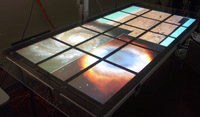EVL Director Discusses Advanced Techniques In LSU Center For Computation & Technology Distinguished Lecture
May 29th, 2007
Categories: Applications, Devices, Education, Multimedia, Networking, Software, Supercomputing, Tele-Immersion, Visualization, VR

About
2007-May-29
Baton Rouge - Sight is a person’s primary sense, and one-third of a person’s brainpower is spent processing visual images. Therefore, visualization is becoming a primary means for scientists and researchers to explore new territory and show new concepts to the general public.
Jason Leigh, director of the Electronic Visualization Laboratory at the University of Illinois (Chicago), discussed advanced visualization research and collaboration in a Distinguished Lecture Series for the LSU Center for Computation & Technology, or CCT.
Leigh explained the guiding principle of his lab is that the best visualization advances occur by pairing researchers from science, art and industry, then seeing how computer science techniques apply to these areas.
“In order to do effective visualization, we need to work with people from other disciplines,” Leigh explained. Previously, visualization was studied mainly by computer scientists, but now is done in a collaborative effort with artists and others who can use visualization to process complex problems.
Leigh showed examples of the work his lab has done throughout the past 34 years. In the 1970s, the Electronic Visualization Laboratory created the computer graphics that were used in the first “Star Wars” films, an early visualization achievement.